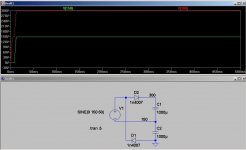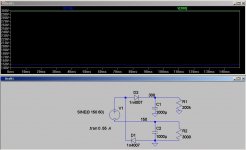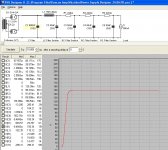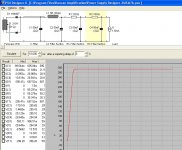I'd like to build a 6EM7 SE tube amp, and possibly progress to a 6EM7 push-pull at a later date. The only hitch is the widely disparate voltages required by the two triode sections.
Going by the datasheet, the voltage amp section typically runs at 300vdc/1.5 mA, and the power triode operates at 150vdc/50mA. Several sources I've seen run the power triode at about 230vdc/38-39 mA (still not exceeding the 10 watt maximum for plate dissipation).
Basically, we need anywhere from a 70 to 150 volt difference between the two triode supply voltages. It seems there are three approaches to this problem.
The first is the brute-force approach:a high-voltage supply with a big dropping resistor to get the voltage down for the output triode. This is the approach Gary Kaufman uses in his 6EM7 amp, but I'm not real happy with the idea of burning so much current through a big resistor.
The second approach would be a lower-voltage supply to feed the B+ to the outputs, with a tap off the transformer AC and a doubler to supply the few milliamps necessary for the input section.
The third approach would be to use a transformer with multiple taps, such as an Edcor XPWR100-120 (240-180-0-180-240), and use dual rectifier/filter circuits. [I'm not sure the XPWR100-120 would be up to the task for a stereo amp, as it's rated for only 120mA. I'd probably need to order a custom wind from Edcor with 175-200 mA capability.]
Do any of you have experience building a dual supply which provided a lower voltage at high current, and a high voltage at low current? Suggestions, as always, would be much appreciated.
Going by the datasheet, the voltage amp section typically runs at 300vdc/1.5 mA, and the power triode operates at 150vdc/50mA. Several sources I've seen run the power triode at about 230vdc/38-39 mA (still not exceeding the 10 watt maximum for plate dissipation).
Basically, we need anywhere from a 70 to 150 volt difference between the two triode supply voltages. It seems there are three approaches to this problem.
The first is the brute-force approach:a high-voltage supply with a big dropping resistor to get the voltage down for the output triode. This is the approach Gary Kaufman uses in his 6EM7 amp, but I'm not real happy with the idea of burning so much current through a big resistor.
The second approach would be a lower-voltage supply to feed the B+ to the outputs, with a tap off the transformer AC and a doubler to supply the few milliamps necessary for the input section.
The third approach would be to use a transformer with multiple taps, such as an Edcor XPWR100-120 (240-180-0-180-240), and use dual rectifier/filter circuits. [I'm not sure the XPWR100-120 would be up to the task for a stereo amp, as it's rated for only 120mA. I'd probably need to order a custom wind from Edcor with 175-200 mA capability.]
Do any of you have experience building a dual supply which provided a lower voltage at high current, and a high voltage at low current? Suggestions, as always, would be much appreciated.
After sleeping on the question overnight, the answer became obvious. Only a single-voltage power transformer is needed; something around 210 to 220 volts.
A tube-rectified, choke-input filter provides the B+ for the high-current, low-voltage output triode. A second filter string, with solid-state diodes and a fairly large input capacitor, supplies the low-current, high-voltage input stage. Both Ac-to-DC filter stages are fed by the same transformer taps.
I need to play with the component values a bit, but here's the idea for the two different filter sections:
A tube-rectified, choke-input filter provides the B+ for the high-current, low-voltage output triode. A second filter string, with solid-state diodes and a fairly large input capacitor, supplies the low-current, high-voltage input stage. Both Ac-to-DC filter stages are fed by the same transformer taps.
I need to play with the component values a bit, but here's the idea for the two different filter sections:
Attachments
6EM7 is happy running on anything up to 330 volts on either section of the tube. (I've run higher voltages than 150v with a 13DE7, very similar tube, and am planning to use the 9 pin version of the 6EM7 in a future amp at about 320v for both sections). Just use one supply and plot the curves accordingly. The 150 volts in the datasheet are there as an example for the typical application as a vertical deflection amp, not an absolute. Personally, I use a series regulator using a MOSFET and a voltage reference from a zener string or a voltage divider to give me a nice regulated DC voltage with only a very small loss.
- Status
- This old topic is closed. If you want to reopen this topic, contact a moderator using the "Report Post" button.



